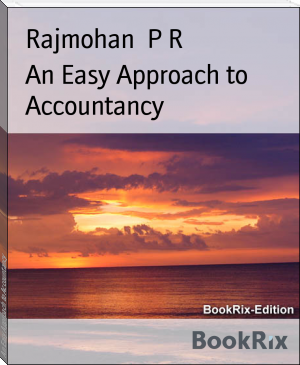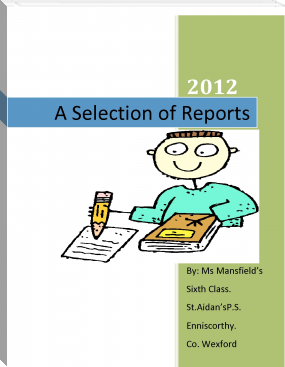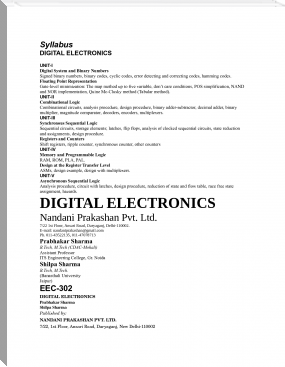An Easy Approach to Accountancy by Rajmohan P R (good novels to read TXT) 📕

- Author: Rajmohan P R
Book online «An Easy Approach to Accountancy by Rajmohan P R (good novels to read TXT) 📕». Author Rajmohan P R
This accounting basics will introduce you to some basic accounting principles, accounting concepts, and accounting terminology. Some of the basic accounting terms that you will learn include revenues, expenses, assets, liabilities, income statement, balance sheet, and statement of cash flows. You will become familiar with accounting debits and credits as we show you how to record transactions. You will also see why two basic accounting principles, the revenue recognition principle and the matching principle, assure that a company's income statement reports a company's profitability.
Income Statement
Income statement will show how profitable .Direct Delivery has been during the time interval shown in the statement's heading. This period of time might be a week, a month, three months, five weeks, or a year.
The reporting of profitability involves two things: the amount that was earned (revenues) and the expenses necessary to earn the revenues. As you will see next, the term revenues is not the same as receipts, and the term expenses involves more than just writing a check to pay a bill. its purpose is to (1) report the revenues earned by the company's efforts during the period, and (2) report the expenses incurred by the company during the same period. The purpose of the income statement is to show a company's profitability during a specific period of time. The difference (or "net") between the revenues and expenses for Direct Delivery is often referred to as the bottom line and it is labeled as either Net Income or Net Loss.
A. Revenues
The main revenues for Direct Delivery are the fees it earns for delivering materials. Under the accrual basis of accounting revenues are recorded when they are earned, not when the company receives the money. Recording revenues when they are earned is the result of one of the basic accounting principles known as the revenue recognition principle.
B. Expenses
The income statement should show expenses incurred during the Month regardless of when the company actually paid for the expenses. What matters is when the work was done—when the expense was incurred—and in this case, the work was done in the Month. The recording of expenses with the related revenues is associated with another basic accounting principle known as the matching principle. Interest Expense on borrowed money. wages expense, Other expenses if any.
Balance Sheet - Assets
Financial statement that reports the amount of a company's (A) assets, (B) liabilities, and (C) stockholders' (or owner's) equity at a specific point in time. Because the balance sheet reflects a specific point in time rather than a period of time, Marilyn likes to refer to the balance sheet as a "snapshot" of a company's financial position at a given moment.
Assets
Assets are things that a company owns and are sometimes referred to as the resources of the company. Joe readily understands this—off the top of his head he names things such as the company's vehicle, its cash in the bank, all of the supplies he has on hand, and the dolly he uses to help move the heavier parcels. Marilyn nods and shows Joe how these are reported in accounts called Vehicles, Cash, Supplies, and Equipment. She mentions one asset Joe hadn't considered—Accounts Receivable. If Joe delivers parcels, but isn't paid immediately for the delivery, the amount owed to Direct Delivery is an asset known as Accounts Receivable.
Prepaid Expenses
The un-expired portion of prepaid expenses in an asset account called Prepaid Expenses.
Cost Principle and Conservatism
Company's asset was recorded at its original cost, and even if the fair market value of an item increases, an accountant will not increase the recorded amount of that asset on the balance sheet. This is the result of another basic accounting principle known as the cost principle.
In short, the cost principle generally prevents assets from being reported at more than cost, while conservatism might require assets to be reported at less than their cost.
Depreciation
The reported amounts on his balance sheet for assets such as equipment, vehicles, and buildings are routinely reduced by depreciation. Depreciation is required by the basic accounting principle known as the matching principle. Depreciation is used for assets whose life is not indefinite—equipment wears out, vehicles become too old and costly to maintain, buildings age, and some assets become obsolete. Depreciation is the allocation of the cost of the asset to Depreciation Expense on the income statement over its useful life.
The asset Land is not depreciated, so it will appear at its original cost even if the land is now worth one hundred times more than its cost.
Short-term (current) asset amounts are likely to be close to their market values, since they tend to "turn over" in relatively short periods of time.
Balance Sheet - Liabilities and Stockholders' Equity
(B) Liabilities
The balance sheet reports Direct Delivery's liabilities as of the date noted in the heading of the balance sheet. Liabilities are obligations of the company; they are amounts owed to others as of the balance sheet date.Interest Payable,Wages Payable etc.
(C) Stockholders' Equity
If the company is a corporation, the third section of a corporation's balance sheet is Stockholders' Equity. (If the company is a sole proprietorship, it is referred to as Owner's Equity.) The amount of Stockholders' Equity is exactly the difference between the asset amounts and the liability amounts. As a result accountants often refer to Stockholders' Equity as the difference (or residual) of assets minus liabilities. Stockholders' Equity is also the "book value" of the corporation.
Since the corporation's assets are shown at cost or lower (and not at their market values) it is important that you do not associate the reported amount of Stockholders' Equity with the market value of the corporation. (Hence, it is a poor choice of words to refer to Stockholders' Equity as the corporation's "net worth".) To find the market value of a corporation, you should obtain the services of a professional familiar with valuing businesses.
Within the Stockholders' Equity section you may see accounts such a Common Stock, Paid-in Capital in Excess of Par Value-Common Stock, Preferred Stock, Retained Earnings, and Current Year's Net Income.
The account Common Stock will be increased when the corporation issues shares of stock in exchange for cash (or some other asset). Another account Retained Earnings will increase when the corporation earns a profit. There will be a decrease when the corporation has a net loss. This means that revenues will automatically cause an increase in Stockholders' Equity and expenses will automatically cause adecrease in Stockholders' Equity. This illustrates a link between a company's balance sheet and income statement.
Statement of Cash Flows
The third financial statement that Joe needs to understand is the Statement of Cash Flows. This statement shows how Direct Delivery's cash amount has changed during the time interval shown in the heading of the statement.Cash generated and used by his company's operating activities, its investing activities, and its financing activities. Much of the information on this financial statement will come from Direct Delivery's balance sheets and income statements.
Double Entry System
Double entry is a simple yet powerful concept: each and every one of a company's transactions will result in an amount recorded into at least two of the accounts in the accounting system.
The Chart of Accounts
To begin the process of setting up Joe's accounting system, he will need to make a detailed listing of all the names of the accounts that Direct Delivery, Inc. might find useful for reporting transactions. This detailed listing is referred to as a chart of accounts.
In double entry system, all of Direct Delivery's transactions will involve a combination of two or more accounts from the balance sheet and/or the income statement. Marilyn lists out some sample accounts that Joe will probably need to include on his chart of accounts:
Balance Sheet accounts:
Asset accounts (Examples: Cash, Accounts Receivable, Supplies, Equipment)
Liability accounts (Examples: Notes Payable, Accounts Payable, Wages Payable)
Stockholders' Equity accounts (Examples: Common Stock, Retained Earnings)
Income Statement accounts:
Revenue accounts (Examples: Service Revenues, Investment Revenues)
Expense accounts (Examples: Wages Expense, Rent Expense,Depreciation Expense)
Debits and Credits
Did the first sample transaction follow the double entry system and affect two or more accounts? Joe looks at the balance sheet again and answers yes, both Cash and Common Stock were affected by the transaction.
Marilyn introduces the next basic accounting concept: the double entry system requires that the same dollar amount of the transaction must be entered on both theleft side of one account, and on the right side of another account. Instead of the word left, accountants use the word debit; and instead of the word right, accountants use the word credit.
Let's take a look at the accounting equation again:
Since many transactions involve cash, a transaction involves cash: if Direct Delivery receives cash, the Cash account is debited; when Direct Delivery pays cash, the Cash account is credited.
. Since cash was received, the Cash account will be debited.
In keeping with double entry, two (or more) accounts need to be involved. Because the first account (Cash) was debited, the second account needs to be credited. All Joe needs to do is find the right account to credit. In this case, the second account is Common Stock. Common stock is part of stockholders' equity, which is on the right side of the accounting equation. As a result, it should have a credit balance, and to increase its balance the account needs to be credited.
Let's consider this transaction. Using double entry, we know there must be a minimum of two accounts involved—one (or more) of the accounts must be debited, and one (or more) must be credited.
Since a check is written, we know that one of the accounts involved is Cash. Since cash was paid, the Cash account will be credited. (Take another look at the last TIP.) While we have not yet identified the second account, what we do know for certain is that the second account will have to be debited.
We know the transaction involves insurance, and a quick look through the chart of accounts reveals two possibilities:
Prepaid Insurance (an asset account reported on the balance sheet) and Insurance Expense (an expense account reported on the income statement)
Revenues accounts are credited when the company earns a fee (or sells merchandise) regardless of whether cash is received at the time.
Let's identify the two accounts involved and determine which needs a debit and which needs a credit.
Because Direct Delivery has earned the fees, one account will be a revenues account, such as Service Revenues. (If you refer back to the last TIP, you will read that revenue accounts—such as Service Revenues—are usually credited, meaning the second account will need to be debited.)
If a company does not pay cash immediately, you cannot credit Cash. But because the company owes someone the money for its purchase, we say it has anobligation or liability to pay. Most accounts involved with obligations have the word "payable" in their name, and one of the most frequently used accounts is Accounts Payable. Also keep in mind that expenses are almost always debited.
Here's a Tip
Expenses are (almost) always debited.
Here's a Tip
If a company does not pay cash right away for an expense or for an asset, you cannot credit Cash. Because the company owes someone the money for its purchase, we say it has an obligation or liability to pay. The most likely liability account involved in business obligations is Accounts Payable.
When a company pays cash for something, the company will credit Cash and will have to debit a second account. Assuming that a company preparesmonthly financial statements—
If the amount is used up or will expire in the current month, the account to be debited will be an expense account. (Advertising Expense,Rent Expense, Wages Expense are three examples.)
If the amount is not used up or does not expire in the current month, the account to be debited will be an asset account. (Examples arePrepaid Insurance, Supplies, Prepaid Rent, Prepaid Advertising,Prepaid Association Dues, Land, Buildings, and Equipment.)
If the amount reduces a company's obligations, the account to be debited will be a liability account. (Examples include Accounts Payable, Notes Payable, Wages Payable, and Interest Payable.)
When a company receives cash, the company will debit Cash and will have to credit another account. Assuming that a company will prepare monthly financial statements—
If the amount received is from a cash sale, or for a service that has just been performed but has not yet been recorded, the account to be credited is a revenue account such as Service Revenues or Fees Earned.
If the amount received is an advance payment for a service that has not yet been performed or earned, the account to be credited is Unearned





Comments (0)